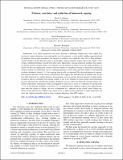Patterns, correlates, and reduction of homework copying
Author(s)
Palazzo, David J.; Lee, Young-Jin; Warnakulasooriya, Rasil; Pritchard, David E.
DownloadPalazzo-2010-Patterns, correlates.pdf (455.3Kb)
PUBLISHER_POLICY
Publisher Policy
Article is made available in accordance with the publisher's policy and may be subject to US copyright law. Please refer to the publisher's site for terms of use.
Terms of use
Metadata
Show full item recordAbstract
Submissions to an online homework tutor were analyzed to determine whether they were copied. The fraction of copied submissions increased rapidly over the semester, as each weekly deadline approached and for problems later in each assignment. The majority of students, who copied less than 10% of their problems, worked steadily over the three days prior to the deadline, whereas repetitive copiers (those who copied >30% of their submitted problems) exerted little effort early. Importantly, copying homework problems that require an analytic answer correlates with a 2(σ) decline over the semester in relative score for similar problems on exams but does not significantly correlate with the amount of conceptual learning as measured by pretesting and post-testing. An anonymous survey containing questions used in many previous studies of self-reported academic dishonesty showed ∼1/3 less copying than actually was detected. The observed patterns of copying, free response questions on the survey, and interview data suggest that time pressure on students who do not start their homework in a timely fashion is the proximate cause of copying. Several measures of initial ability in math or physics correlated with copying weakly or not at all. Changes in course format and instructional practices that previous self-reported academic dishonesty surveys and/or the observed copying patterns suggested would reduce copying have been accompanied by more than a factor of 4 reduction of copying from ∼11% of all electronic problems to less than 3%. As expected (since repetitive copiers have approximately three times the chance of failing), this was accompanied by a reduction in the overall course failure rate. Survey results indicate that students copy almost twice as much written homework as online homework and show that students nationally admit to more academic dishonesty than MIT students.
Date issued
2010-03Department
Massachusetts Institute of Technology. Department of PhysicsJournal
Physical Review Special Topics. Physics Education Research
Publisher
American Physical Society
Citation
Palazzo, David J., Lee, Young-Jin, Warnakulasooriya, Rasil and Pritchard, David E. (2010). Patterns, correlates, and reduction of homework copying. Phys. Rev. ST Phys. Educ. Res. 6:010104/1-11. © 2010 The American Physical Society
Version: Final published version
ISSN
1554-9178